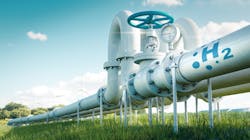SDG&E Hydrogen Pilot to Assess Hydrogen’s Feasibility as a Decarbonization Tool
San Diego Gas & Electric Company (SDG&E) submitted a proposal with the California Public Utilities Commission (CPUC) on Sept. 8 for a demonstration project on the University of California San Diego (UC San Diego) campus to study how blending hydrogen with natural gas in the existing gas system could help achieve a successful energy transition for all Californians.
The project is part of SDG&E’s multi-pronged sustainability strategy to explore the feasibility of emerging technologies to rapidly decarbonize multiple economic sectors – from buildings and transportation to industrial and manufacturing processes – to help California reach its carbon neutrality goal by 2045. If approved by the CPUC, the project would study the feasibility of injecting up to 20% of hydrogen into plastic natural gas pipe, a common material used in the natural gas infrastructure. An isolated section of a gas line serving a UC San Diego apartment complex would use hydrogen blended gas for common building equipment such as boilers and water heaters. Hydrogen used in this study would be produced onsite via a dedicated, grid-connected electrolyzer. The results of the study would help inform the development of a renewable hydrogen blending standard for California.The UC system and UC San Diego have long been sustainability leaders. The UC system aims to achieve net zero greenhouse gas emissions from its buildings and fleet by 2025. UC San Diego is a global leader in advanced battery and energy storage research and deployment, and it’s home to a microgrid powered by a fuel cell and the Deep Decarbonization Initiative.
The project would fulfill a key recommendation in a recent “Hydrogen Blending Impacts” study (sponsored by the CPUC and performed by UC Riverside) calling on utilities to conduct “real world demonstration of hydrogen blending” to fill knowledge gaps that cannot be addressed through modeling or lab experiments.
“Because of California’s abundant solar energy resource and strong history of clean energy innovation, we are well-positioned to pioneer a clean hydrogen economy,” said state Senator Ben Hueso, who represents the San Diego and Imperial County areas. “California is at a critical juncture in the energy transition where investments in research, development and demonstration of hydrogen and other emerging technologies are necessary to accelerate decarbonization.”
SDG&E and UC San Diego will work closely together during all the phases of the project to implement safety protocols, conduct public outreach, and identify research opportunities with students and faculty.
Submitted as part of a joint filing with SoCalGas and Southwest Gas on Sept. 8, SDG&E’s proposal builds upon the latest research and international experiences, including the HyDeploy pilot in the UK. That project demonstrated the injection of up to 20% of hydrogen into a university’s natural gas network, suggesting that blending hydrogen up to 20% by volume does not interact negatively with existing materials used within infrastructure like network pipes or in homes or businesses.
Hydrogen is already used in many industrial and manufacturing processes, including fertilizer and steel production. A versatile energy carrier, it can be used to move, store and deliver energy made from other sources. California can potentially harness, rather than curtail, its excess renewable energy to produce hydrogen. This clean hydrogen could then be injected into gas pipelines, used to power fuel cell vehicles, or stored for months at a time and converted back into electricity when it's needed.
SDG&E’s proposal comes at a time when the U.S. government is gearing up to invest $9.5 billion in clean hydrogen initiatives as part of the 2021 Infrastructure Investment and Jobs Act. To further accelerate the development of a hydrogen economy, Congress in August passed the Inflation Reduction Act, which will provide a new clean hydrogen production tax credit of up to $3 per kilogram. California announced its intention earlier this year to leverage federal and state dollars to create a renewable hydrogen hub and accelerate hydrogen market development. Governments in Asia and Europe have also launched ambitious hydrogen initiatives.
As part of the project, new pipe would be installed to isolate specific buildings from the surrounding area, along with a hydrogen storage tank, a hydrogen blender, and an electrolyzer that would produce hydrogen by splitting water into hydrogen and oxygen. The electrolyzer is expected to use about a third of the water an average household consumes in a year. Construction would start in Q2 2024 with blending occurring in late 2024 through early 2026. The site would be fully restored to its original condition upon conclusion of the project.
